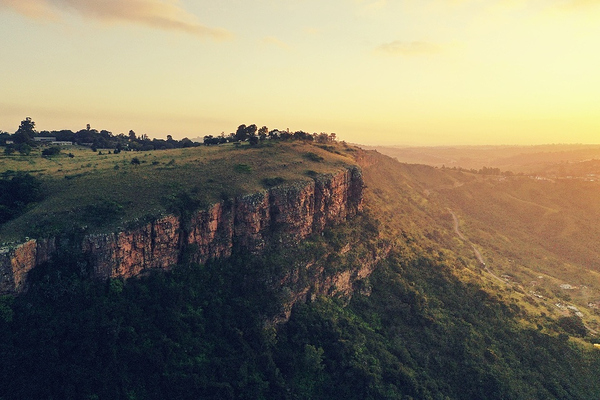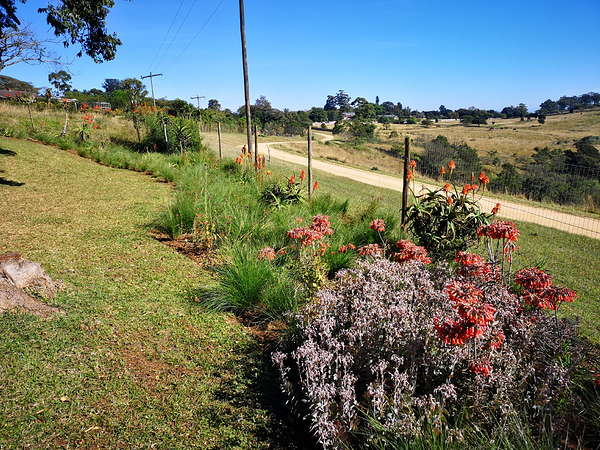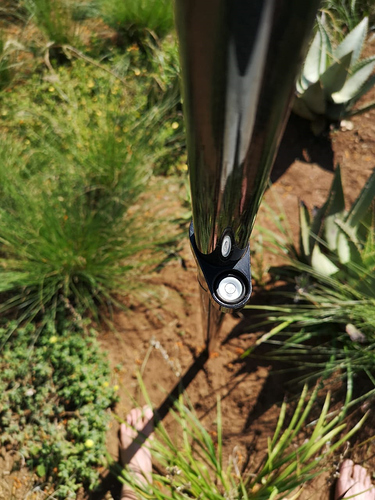One of my passions is indigenous gardening. I don’t spend much time at home but when I am back, I prefer to spend my time in the garden, nursery’s and wild bush (veld) getting inspiration, learning and ultimately gaining samples. I have begun rehabilitation of a relatively new garden (2 years old) from an overgrown, choked by exotic weeds, decades of “gardening” with weedkiller and pesticides.
Kwazulu Natal Sandstone Sourveld
The plot is not very big, only 15m x 80m and had to be initially stripped of lantana, wattle saplings, kakhi bush, etc. This labour intensive work was left to the summer when the ground was soft due to rainfall. Basic pioneer grasses (aristida) where planted to give a base layer, protecting the soil and giving shade to the young plants.
Strip of rehabilitated garden, ready for planting
I may be a bit of a puritan when it comes to indigenous planting. I enjoy the KZN Standstone Sourveld grasslands in our part of the world here (coastal parts of KwaZulu-Natal, South Africa) and am trying to replicate that. Thus all vegetation needs to naturally occur within 150km from my home. Our grasslands are under severe threat from development, pollution and erosion from overgrazing and stormwater run-off. Grasslands are no longer being seasonally burnt which leads to overgrowth of larger bushes and trees, killing off smaller grasses and bulbs.
Earlier planting from 2 years ago
One of the hidden treasures in the KZNSS are the bulbs that live amongst the grasses. These bulbs are generally hidden though the winter months due to burning of the veld. Come spring to summer, these often produce very showy flower spikes, balls and plumes, cutting a stark display among the sea of green leaves. The bulbs are highly sought after by traditional medicine men (and women) called Inyangas. These bulbs are collected by their apprentices and used for traditional cures for a variety of ailments. Sometimes even for negative purposes like poison and casting spells. The belief is that the older the plant, the more potent it is. The problem has come in that people now see these bulbs as a cash crop and often strip the landscape in their search for free money. Specialist nurseries have now been developed to help restore the balance and provide a legal way of obtaining some of these endemic plants.
The cost of these slow growing and often finicky plants is very high. I luckily came across a cultivator at an agricultural show recently and bought a fair bit from him. Last winter, I planted a lot of these bulbs but a lot where eaten by caterpillars, moles or otherwise died due to over-watering, etc. The problem come in that I often forgot what and where I planted them and didnt give them the care that they needed. Like in nature, the planting is irregular and not easy to relocate. We initially used flags to indicate the locations, but my clever dogs realised quickly what those flags meant (normally used for survey markers) and retrieved them all for me like they are trained to do after a field survey out on site. So I figured I would start my own database of planting and use the RS2 to help record the locations.
Strange looking Watsonia Grandiflora bulb
Having used the single frequency RS before in my garden, I know that the large surrounding trees impede an RTK fix. Because I was being lazy and didnt want to drive far away to erect a base (it was a Sunday after all), I decided to use the NTRIP service in our area, but the baseline to my closest mountpoint would be 40km. Again, too far and difficult for single frequency. So I decided to use my shiny new dual frequency RS2. Having dual frequency means longer baselines and a stable, reliable fix when close to dense foliage and buildings. Another advantage is that the time to fix is really short, in my case, 8 seconds.
Useless gardening assistant
After carefully deciding where each species should go, I enlisted the services of my reluctant helper to assist in preparing the soil for each bulb. Care must be made to not overly disturb the soil as it encourages weeds and subsequently insects to the location and may cause caterpillars, termites or others to call the bulb their new local McDonald’s. Each location was then recorded using the RS2 via the Survey app and exported to Shapefile for storing on my new home GIS.
Over the next few months, the plan is to check the locations from time to time. Between now and when the rains begin in Spring is the most crucial. The bulbs dont like to be disturbed while they put out tiny roots. Visitors to our garden such as rock hyrax, hares, antelope and porcupines tend to be attracted to these disturbed patches of ground and have a habit of unearthing the bulbs as they look for termites, toads, etc. My useless gardening assistant promises to look after them as best he can! So using the RS2, I can pin point each spot and check on progress. When the first leaves come out in late spring / summer, insecticide needs to be applied to certain species as caterpillars are really fond of the young shoots and burrow inside the bulbs, causing them to implode. Again, the RS2 will be useful to filter those varieties and pick out only those.
Another feature will be that in future, the eventual failure of my memory will occur, and the RS2 will still be a good reminder as what was planted and when!













